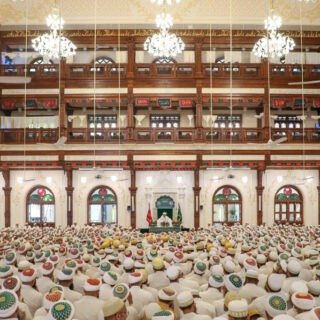We share many attributes with other creatures, but clothing ourselves is distinct to us. There is a social, moral, cultural and spiritual dimension to human clothing.
Expounding the prime reason for clothing, Allah Ta´ala states in the Quran:
O Children of Adam! We have bestowed raiment upon you to cover your intimate parts and as an adornment; and the raiment of taqwa, that is better.
This verse stresses the concealing feature of clothing. Clothes which do not conceal the body as directed by the sharia are void of the first and foremost characteristic by which Allah describes libaas.
As primary benefits of clothing, protection and modesty spring first to mind, but our clothes do far more. Clothing is one of the most basic forms of communication. Long before our voices are heard, our clothes transmit multiple messages to on-lookers.
Common wisdom says, “Do not judge a book by its cover.” But this is only partly true; we tend to read each other on a regular basis. Research suggests that if you stand someone before an audience of strangers and ask them to draw inferences merely on the basis of what they see, the audience’s inferences will be more or less accurate. Judgements based on observation carry value and are deemed valid to a great extent.
Because our clothing is one of the fundamental means of communicating with others, what we wear is never solely a personal matter. Being affiliated to Awliyaullah AS, a Mumin has to keep in mind the dignity of his religion and culture. A Mumin’s dress code is governed by Awliyaullah AS. One may argue that Allah knows his intentions and beliefs. His dress has nothing to do with his belief and faith. However, our internal and external states cannot be so easily detached from one another. The fact is, when it comes to how we clothe ourselves, our external appearance is often an expression of our internal state. Our attire is the manifestation of what we think and believe.
There are numerous references to libaas (clothing) in the annals of Fatemi history. Each reference highlights the deep and profound meaning libaas has:
- Rasulullah SAW placed his paghdi on the raas mubarak of Amirul Mumineen Maulana Ali AS.
- Imam Moiz SA sent his libaas to Maulana al-Qaid Johar after bidding him farewell as he set out to conquer Misr.
- Syedna Qutbuddin al-Shahid RA placed his paghdi on the raas mubarak of Syedna Feerkhan Shujauddin RA
- Syedna Abdeali Saifuddin RA bestowed Syedna Abdulqadir Najmuddin RA with the libaas of his son Syedna Mohammed Badruddin RA
- Syedna Mohammed Burhanuddin RA granted his own jaama and dupatta to Syedna Aali Qadr Mufaddal Saifuddin TUS when he was in Indore for delivering asharah mubarakah for the first time
Extensive research has been carried out on the notion of “You are what you wear.” The study of “Enclothed Cognition” reveals that there is a systematic influence of clothes on the wearer’s psychological processes. The dress influences the thoughts, feelings and actions of the wearer. The soldier feels different in his uniform than he does in civil attire.
Benevolently, Awliyaullah AS have graced Mumineen with the libaas that they wear. History tells us that monarchs and kings have not permitted the common man to imitate them in their dress code. However, Awliyaullah AS have not only permitted us but have actively encouraged us to do so.
Libaas al-Anwar; topi, kurtaa, saya and ridaa’ are purely Fatemi in their design. The name (Libaas al-Anwar) directs one’s thoughts towards al-Jame´ al-Anwar. At its inauguration, seeing Mumineen’s appearance that reflected their faith, Syedna Mohammed Burhanuddin RA declared, “You have come back here as you had departed.” This statement is the stamp of recognition and acknowledgement of a mumin’s true identity.
As said earlier, how we dress not only affects others; it also affects us. A mumin in Libaas al-Anwar will think, feel and behave more responsibly, as he is representing his faith. Libaas al-Anwar is the epitome of modesty and protection of one’s self, the reason for which Allah has adorned mankind with raiment. Many a times, Syedna al-Dai al-Ajal TUS has mentioned “fashion waali ridaa’” to discourage Mumineen from acquiring a dress code that violates the very basic concepts of libaas. Libaas al-Anwar saves Mumineen from indulging in acts that would not suit their identity.
Highlighting this important feature of our libaas, Syedna Mohammed Burhanuddin RA stated:
“Others may indulge in muharramaat like smoking and drugs, but a mumin should not. We are different from them. Even a single stain upon a white cloth shows up distinctively. While coloured clothes tend to cover up the spots. And, if the cloth is black in colour, it does not show where the spots are. Thus, people whose hearts are blackened due to their ill beliefs, they do not care about committing sins.”
A mumin is pure and white in his beliefs. He should not allow black spots to smear his imaani individuality and cultural identity.
May Allah protect Fatemi Thaqaafat in our descendants. May He grant our Maula Syedna Aali Qadr Mufaddal Saifuddin TUS the custodian of Fatemi Thaqaafat a long and prosperous life till the day of Qiyaamat.









